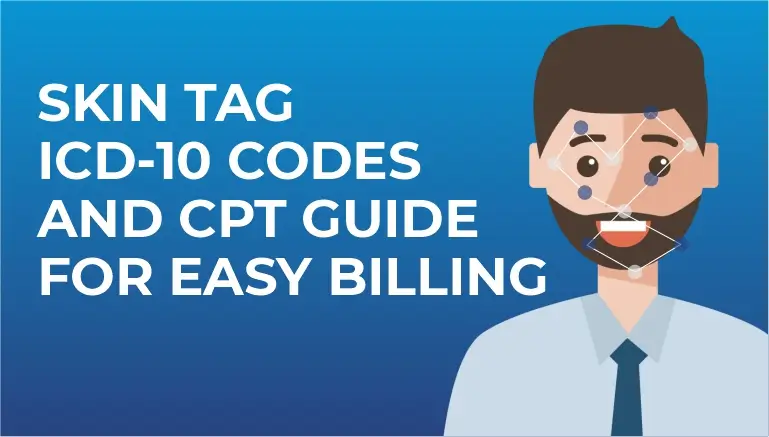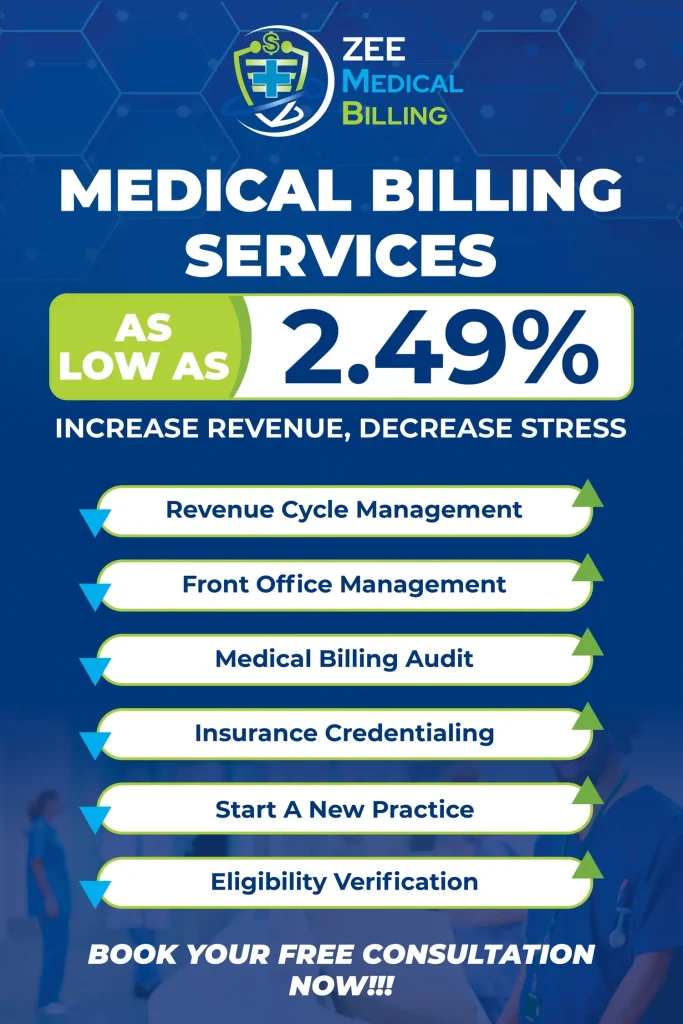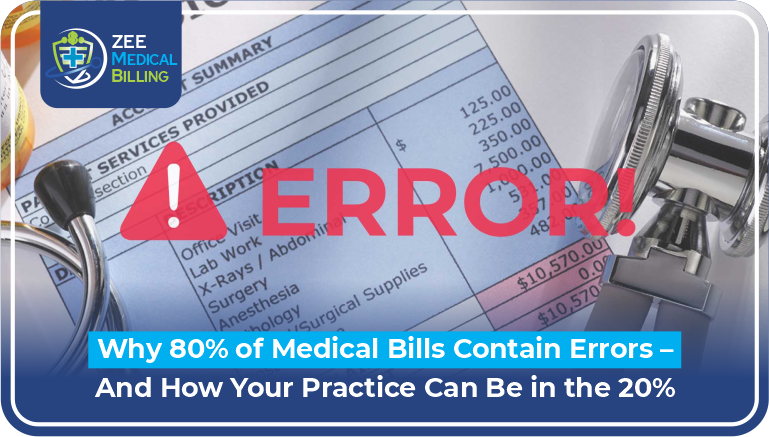Skin tags, or acrochordons, are common and harmless skin growths. They often appear in places where the skin folds, such as the neck, underarms, and eyelids. While usually harmless, many people seek to have them removed for cosmetic reasons or because they become irritated.
From a billing and coding perspective, correctly using ICD-10 codes for skin tags and CPT codes for skin tag removal is crucial. Proper documentation ensures that claims are approved and reimbursements are processed without delay.
In this guide, we will explain the skin tag ICD-10 codes, cover the CPT codes for removal, and show you how to make the billing process easier.
What Is a Skin Tag?
Skin tags are small, soft, flesh-colored growths that hang from the skin. They consist of collagen fibers and blood vessels and typically cause no pain. However, they can get irritated by clothing or jewelry, leading many to consider removal.
Medical professionals often refer to them as acrochordons, and the term is important for accurate coding.
Read More: What Are PCN, RXBIN & Policy Numbers on Insurance Cards?
ICD-10 Code for Skin Tags
When billing for a skin tag diagnosis, using the correct ICD-10 code is important. The official ICD 10 code for the skin tag is:
- L91.8 – Other hypertrophic disorders of the skin
This is a general code. The acrochordon ICD-10 is often included here. This is because there is no specific code for “skin tag.”
Other related codes include:
- D23.5 – Other benign neoplasms of the skin of the trunk
- D23.4 – Other benign neoplasms of the skin of the scalp and neck
These may be used depending on the location of the lesion.
Related ICD-10 Codes
- L92.9 – Granulomatous disorder of the skin, unspecified
- D23.9 – Benign neoplasm of skin, unspecified
- L98.9 – Disorder of the skin and subcutaneous tissue, unspecified
Always document the anatomical location to use the most specific ICD-10 code.
CPT Code for Skin Tag Removal
For procedural billing, you must select the correct CPT code for the removal of skin tags. The most commonly used CPT code is:
- CPT 11200 – Removal of skin tags, multiple fibrocutaneous tags, any area; up to and including 15 lesions.
If more than 15 skin tags are removed during the same visit, use:
- CPT 11201 – Each additional 10 lesions (list separately in addition to 11200).
Additional CPT Codes You Might Use
- CPT code for excision of skin tag: If the skin tag is excised rather than snipped or frozen, you may consider lesion excision codes depending on depth and method.
- CPT for skin tag removal: This is typically used with 11200 and 11201 unless more complex excision is performed.
Always check payer-specific guidelines and documentation requirements before coding.
How to Document Skin Tag Removal for Billing
Accurate documentation plays a critical role in getting claims approved. Make sure to include:
- Number and location of lesions
- Reason for removal (e.g., irritation, bleeding, inflammation)
- Method used (snipping, cauterization, cryotherapy)
- Any complications or additional steps
- Patient consent
Using clear terms like fibroepithelial polyp ICD-10 (a medical name for skin tag) can help show the need for removal.
Is Skin Tag Removal Covered by Insurance?
One of the most common questions is: How to get skin tag removal covered by insurance?
Typically, insurance covers skin tag removal only when it’s medically necessary. Insurance companies usually do not reimburse cosmetic removals. To support medical necessity, your documentation must clearly state:
- Skin tags are causing pain or bleeding
- They’re interfering with daily activities
- There’s a risk of infection or constant irritation
Use language that supports a clinical reason rather than aesthetic preference.
Read More: Top 5 Common Medical Billing Mistakes and How to Avoid Them
Common Mistakes in Skin Tag Coding
Avoid these common errors:
- Using L82.1 (seborrheic keratosis) instead of a benign neoplasm code
- Failing to document the number of lesions removed
- Not linking the CPT procedure with an appropriate ICD-10 skin tag diagnosis
- Coding for removal without justification of medical necessity
These mistakes can lead to claim denials and payment delays.
Related Conditions and Codes
While working with skin conditions, you might also encounter similar billing scenarios. Here are some examples:
- Epidermal cyst ICD 10: L72.0
- Heat rash ICD 10: L74.3
- Facial skin rash ICD 10: R21
- ICD-10 for small skin lesion: D23.9
- ICD-10 diagnosis code for vaginal cyst: D27
If you address multiple skin conditions in a single visit, list all appropriate codes along with their corresponding treatments.
FAQs
1. What is the ICD-10 code for skin tag removal?
The provider uses the common diagnosis code L91.8. They bill the procedure with CPT 11200 or 11201. The choice depends on how many lesions there are.
2. Can you use CPT 11200 for a single skin tag?
Yes, you can use CPT 11200 for up to 15 lesions, even if you remove only one. However, some insurers might question the use of a single lesion, so documentation matters.
3. Is skin tag removal considered a cosmetic procedure?
It depends. If the tag causes irritation or bleeding, a doctor may consider it medically necessary. If removed for appearance, it’s cosmetic and likely not covered.
4. What does Acrochordon ICD 10 mean?
“Acrochordon” is the medical term for a skin tag. It falls under L91.8 in the ICD-10 system, covering hypertrophic skin disorders.
5. How should we bill multiple skin tag removals?
Use CPT 11200 for the first 15 and CPT 11201 for each additional 10. Be sure to count and document the results clearly in the clinical notes.
Conclusion
Understanding how to use ICD-10 and CPT codes for skin tag removal is important for billing and receiving payment. Choosing the right ICD 10 code for a skin tag is important, as is matching it with the correct CPT code for removal. Each step helps ensure clean claims and faster payments.
Good documentation and clear reasons for medical necessity are crucial. Knowing when to use CPT 11200 or other procedure codes can really help.
Takeaway: Use the correct diagnosis and procedure codes, justify medical needs, and stay updated with payer-specific rules. This ensures you’re billing smartly, ethically, and successfully every time.
Need more help with coding for dermatology procedures? Stay tuned for more coding guides made simple for busy professionals like you.


























